The NVIDIA GeForce GTX 660 Review: GK106 Fills Out The Kepler Family
by Ryan Smith on September 13, 2012 9:00 AM ESTOC: Power, Temperature, & Noise
Before wrapping things up, we wanted to quickly take a look at the overclocking potential of the GTX 660. As the first GK106 product GTX 660 should give us some idea as to how capable GK106 is at overclocking, though like GK104 we’re eventually at the mercy of NVIDIA’s locked voltages and limited power target control.
In its rawest form, GTX 660 will have two things going against it for overclocking. First and foremost, as the highest clocked GK106 part it’s already starting out at a fairly high clockspeed – 980MHz for reference cards, and upwards of 1050MHz for factory overclocked cards – so there may not be a great deal of overclocking headroom left to exploit. Furthermore because NVIDIA is keeping the power consumption of the card low (it needs to stay under 150W max), the maximum power target is the lowest we’ve seen for any GTX 600 card yet: it’s a mere 110%. As a result even if we can hit a large GPU clock offset, there may not be enough power headroom available to let the GPU regularly reach those speeds.
Memory overclocking on the other hand looks much better. With the same memory controllers and the same spec’d RAM as on the other high-end GTX 600 cards, there’s no reason to believe that the GTX 660 shouldn’t be able to hit equally high memory clocks, which means 6.5GHz+ is a reasonable goal.
| GeForce GTX 660 Overclocking | ||||||
| Ref GTX 660 | EVGA GTX 660 SC | Zotac GTX 660 | Gigabyte GTX 660 OC | |||
| Shipping Core Clock | 980MHz | 1046MHz | 993MHz | 1033MHz | ||
| Shipping Max Boost Clock | 1084MHz | 1123MHz | 1110MHz | 1123MHz | ||
| Shipping Memory Clock | 6GHz | 6GHz | 6GHz | 6GHz | ||
| Shipping Max Boost Voltage | 1.175v | 1.175v | 1.162v | 1.175v | ||
| Overclock Core Clock | 1080MHz | 1096MHz | 1093MHz | 1083MHz | ||
| Overclock Max Boost Clock | 1185MHz | 1174MHz | 1215MHz | 1174MHz | ||
| Overclock Memory Clock | 6.7GHz | 6.9GHz | 6.7GHz | 6.5GHz | ||
| Overclock Max Boost Voltage | 1.175v | 1.175v | 1.162v | 1.175v | ||
Throwing in our factory overclocked cards from our companion roundup, our core overclocking experience was remarkably consistent. The difference in the max boost clock between the slowest and fastest card was a mere 41MHz, with the Zotac card being a clear outlier compared to the rest of our cards. This comes as no great surprise since all of these launch cards are using the NVIDIA reference PCB, so there’s little room at this moment for overclocking innovation.
Memory overclocking is as volatile as ever, with a 400MHz spread between our best and worst cards. Again with the use of the reference PCB (and the same Samsung RAM), memory overclocking is entirely the luck of the draw.
For the moment at least GTX 660 overclocking looks to be on a level playing field due to all partners using the same PCB. For overclockers the choice of a card will come down to pricing, what cooler they prefer, and any preference in vendor.
The end result of all of this is that at best we’re seeing 100MHz overclocks (going by the max boost clock), which represents roughly a 10% overclock. Coupling this with a good memory overclock and the 10% increase in the power target will result in around a 10% increase in performance, which isn’t shabby but also is the same kind of shallow overclocking potential that we’ve seen on cards like the GTX 670 and GTX 660 Ti. All told the GTX 660 isn’t a poor overclocker – 10% more performance for free is nothing to sneeze at – but it’s also not going to enamor itself with hardware overclockers who like to chase 20% or more.
Moving on to our performance charts, we’re going to once again start with power, temperature, and noise, before moving on to gaming performance. Due to popular demand we’ll also be including overclocking results with just a 110% power target so that you can see the impact of adjusting the power target separately from the clock offsets.
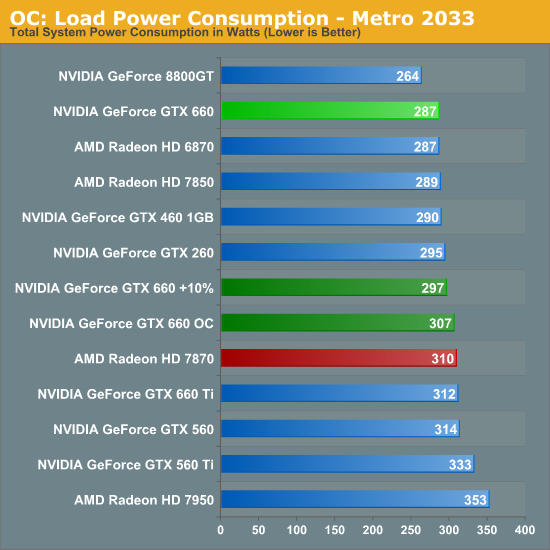
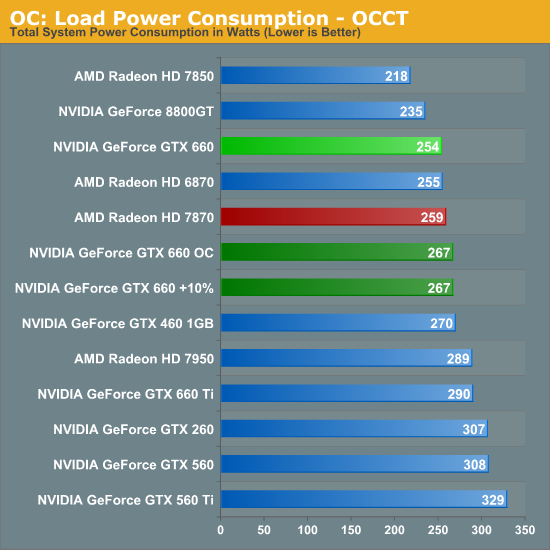
With a 110% power target we should be seeing an 11W-14W increase in power consumption, which is indeed roughly what we’re seeing at the wall after accounting for PSU inefficiencies. In Metro this is just enough of a difference to erase most of the GTX 660’s power consumption advantage over the GTX 660 Ti, though the GTX 660 still draws marginally less power than the stock 7870. Meanwhile under OCCT the GTX 660 now draws more power than the 7870, but still is still drawing over 20W less than the stock GTX 660 Ti.
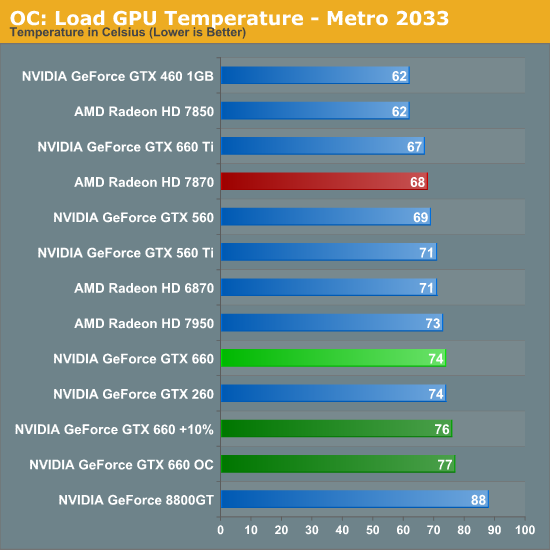
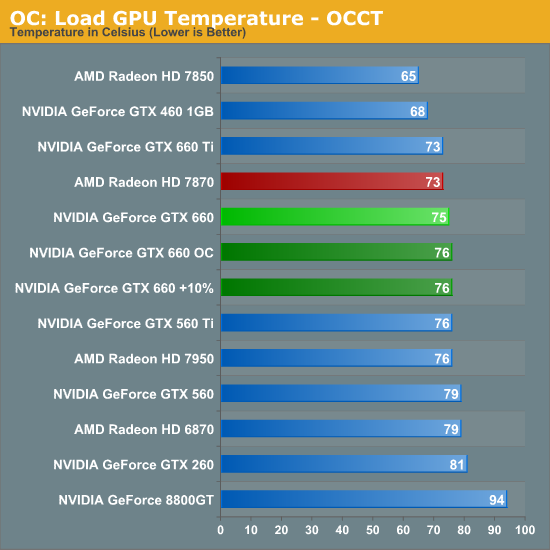
Our increased power consumption pushes temperatures up by another 2-3C. This is nothing a blower can’t handle, let alone an open-air cooler.
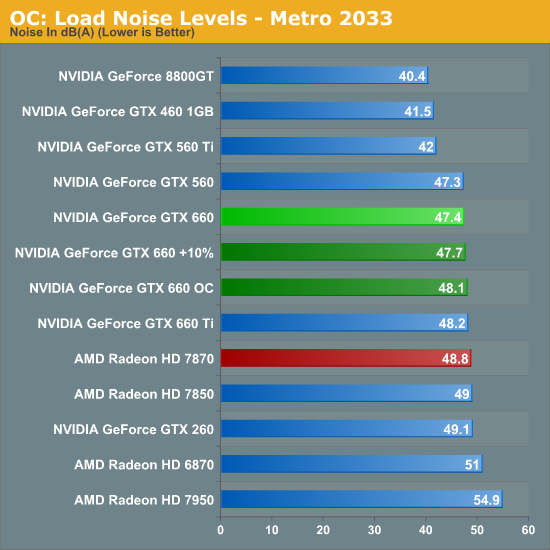
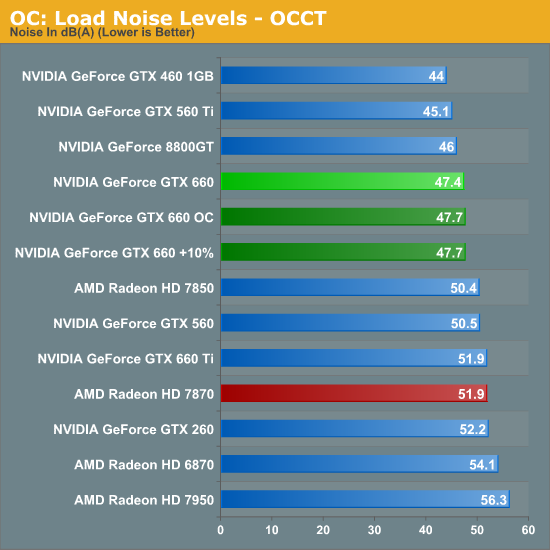
Interestingly enough, despite the increase in power consumption and temperatures, overclocking has almost no impact on noise. In the worst case scenario our GTX 660’s increased its fan speed by all of 2%, which increases noise by less than 1dB. As a result the amount of noise generated by the overclocked GTX 660 is practically identical to that generated by the stock GTX 660, and still below the reference 7870.










147 Comments
View All Comments
Zds - Saturday, September 15, 2012 - link
"Reference clock" is very different from "reference PCB". The operative words are "clock" and "PCB", not "reference".Redshift_91 - Wednesday, September 19, 2012 - link
a superclocked card is not reference clocked, thus the keyword is "reference". Unless you're going to argue that a superclocked card is reference clocked and thus the very idea of overclocking is thrown out the window.guidryp - Thursday, September 13, 2012 - link
"NVIDIA has spent a lot of time in the past couple of years worrying about the 8800GT/9800GT in particular"I am still using a 8800GT without much need to upgrade. I don't play any new games so I really can't justify an upgrade. Though of course you get that upgrade itch. So the first thing I wondered was, how much power/noise compared to my 8800GT (I have giant slow fan on mine).
Anonymous Blowhard - Thursday, September 13, 2012 - link
Now that the 600-series has gotten a firm foothold, older cards like the GTX460 have been available for around $100 if you're patient enough to wait for sales and rebates.Pick one based on the NV reference design if you're concerned about noise; I've had models from MSI and EVGA that both performed admirably in terms of noise and temperature. Blower-style fans can be extremely loud if you buy the wrong model (ZOTAC) so do your homework.
I came from an 8800GT myself and didn't feel the need to upgrade, but there's a definite benefit even in "low end" games based on Source/UE3. The ability to crank up the details/AA and still hold a solid 60fps is wonderful. Well worth the money.
DanNeely - Thursday, September 13, 2012 - link
buying a 2+ generation old high end card is almost never a good idea. What you save upfront over an equivalent lower mid range card is quickly lost due to the significantly higher power draw.rarson - Friday, September 14, 2012 - link
Huh? How expensive is electricity where you live? I can't imagine the power difference making up the cost difference in less than 2 years of constant use.I replaced my 3870 with a 6850 a few months ago, and it actually uses a bit less power at idle, which is where my GPU spends the bulk of its time, so I'm actually saving a tiny bit. Sure, the 460 uses more power under load, but the 880GT uses significantly more power than the 460 during idle (about 20W!).
CeriseCogburn - Thursday, November 29, 2012 - link
If you're worried about 20 watts at idle, you're definitely an amd fanboy.Probably something else too I won't mention since humiliating yourself is already a public past time.
gamara - Thursday, June 6, 2013 - link
20W x 2 days is 1 KW hr. 15 KW hr a month, 180 KW hrs a year. At $.10 a KW hr, that's $18. In California, some places it runs almost triple that, so if you use So Cal Ed, and are in Tier 3 or 4, you pay almost $50 a year extra for those 20 watts.guidryp - Friday, September 14, 2012 - link
I am patient enough to wait for the gtx 660 to get down to $150.If I do upgrade, one thing that is a must, is getting 3+ monitor capability.
I currently drive my TV and desktop monitor, and would like a second desktop monitor.
Here the power usage looks line line with the 8800GT and NVidia finally allows 3+ monitors.
raghu78 - Thursday, September 13, 2012 - link
GTX 660 is actually weak competition. Nvidia's pricing sucks . USD 200 would have really made it an amazing card. Performance wise its stuck between the HD 7850 and HD 7870 but pricing wise its nearer to HD 7870. the GTX 660 is up against a faster chip in the HD 7870. and needs a price correction . GTX 660 OC matches a HD 7870http://www.techpowerup.com/reviews/ASUS/GeForce_GT...
Also anandtech's gaming suite is quite out of date. They are testing Portal 2 which is useless and don't have a single game released in 2012 like Alan Wake, Max Payne 3, Dirt Showdown, Sniper Elite V2, Diablo III, Sleeping Dogs. most sites have started including newer games . hardocp has included sleeping dogs. techpowerup has included alan wake, sniper elite v2, max payne 3, diablo III. techreport has max payne 3 and dirt showdown. And to state that GTX 660 is faster than HD 7870 or the better card with such an obsolete suite is ridiculous